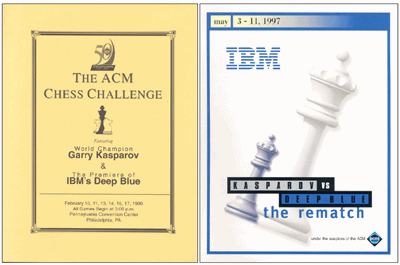'Defending the Human Race?'
In the latest post on 'Top eBay Chess Items by Price', 1958 Portoroz Interzonal, I had a second item on the short list. Titled 'Extremely rare original program for Kasparov vs. Deep Blue Computer Chess Match', it sold for around US $375, 'Best offer accepted'. The description said,
This is an extremely rare original brochure from the match, which was held on May 3–11, 1997 in New York City. This match will echo forever in the history of chess, and mankind, as the first defeat of a reigning world chess champion by a computer under tournament conditions. Several books have already been written of this historic event, including one by Kasparov himself. The audience was small (I was there) and probably not many brochures were kept.
Sensing the historic importance of the event, I made a point to keep mine in pristine condition, but I have never seen another -- other than a copy in a museum -- the Computer Museum. In like new condition, with white glossy pages. 24 pages. The brochure measures 8 1/2 x 11". A special item for collectors of chess or computer and AI memorabilia
The description pointed to a page from the Computer History Museum, Defeating the World Chess Champion | Mastering the Game (computerhistory.org), where the programs for both Kasparov - Deep Blue matches (1996 and 1997) can be downloaded. Here are the front covers of the two programs.

Left: 1996 match;
Right: 1997 match
The 'Welcome' page of the 1997 program says,
Greetings! On behalf of IBM. I would like to welcome you to the IBM Kasparov vs. Deep Blue Rematch. Whether you're with us in New York City or participating in the match via the Internet, we're glad you've joined as for this historic event. We're anticipating a very exciting match.
We at IBM are quite proud of Deep Blue and the team of research scientists who have created it. They are among the hundreds of IBM researchers who work everyday on building, inventing and discovering new technologies which improve our lives and help define the future of computing.
So why has IBM built a machine that plays chess? The applications of the technology we are using in this experiment go far beyond a game. The RS/6000 SP system, the technology underneath Deep Blue, is being used everyday to run businesses. perform technical analysis and conduct scientific experiments. By emulating the Deep Blue architecture -- boosting the power of the SP with specialized processors and software knowledge -- we have plans to apply this awesome power to a variety of disciplines, and expect to see amazing results. By introducing the Deep Blue technology to pharmaceutical drug design, financial risk assessment and decision support problems, for example, we hope to realize faster drug development, stronger economic forecasting and smarter decision making. The possibilities are virtually endless.
There has been much discussion in both public and private forums regarding the significance of this match. Are machines taking over mankind? Have we unleashed a monster? Is Garry Kasparov defending the human race?
We at IBM are very pleased that our experiment has caused such a stir. To us, Deep Blue represents innovation leadership and the unlimited promise of technology. It is not simply man vs. machine, but man and machine striving together to reach new heights -- and reaching them. Welcome to the future.
Sincerely,
Paul M. Horn, Senior Vice President, Research
I once recorded the results of the two matches on my World Chess Championship site: Kasparov vs. IBM's Deep Blue. I wrote,
It's undoubtedly a minority opinion, but some informed observers of the international chess scene believe that Kasparov lost his claim to the World Chess Champion title when he lost his second match to IBM's Deep Blue computer.
More than 20 years later, I'm still not sure what to think. We say 'World Women's Chess Champion' and 'World Junior Chess Champion' when talking about restricted titles. Shouldn't we be saying 'World Human Chess Champion' and leave the unrestricted title to the machines?




No comments:
Post a Comment